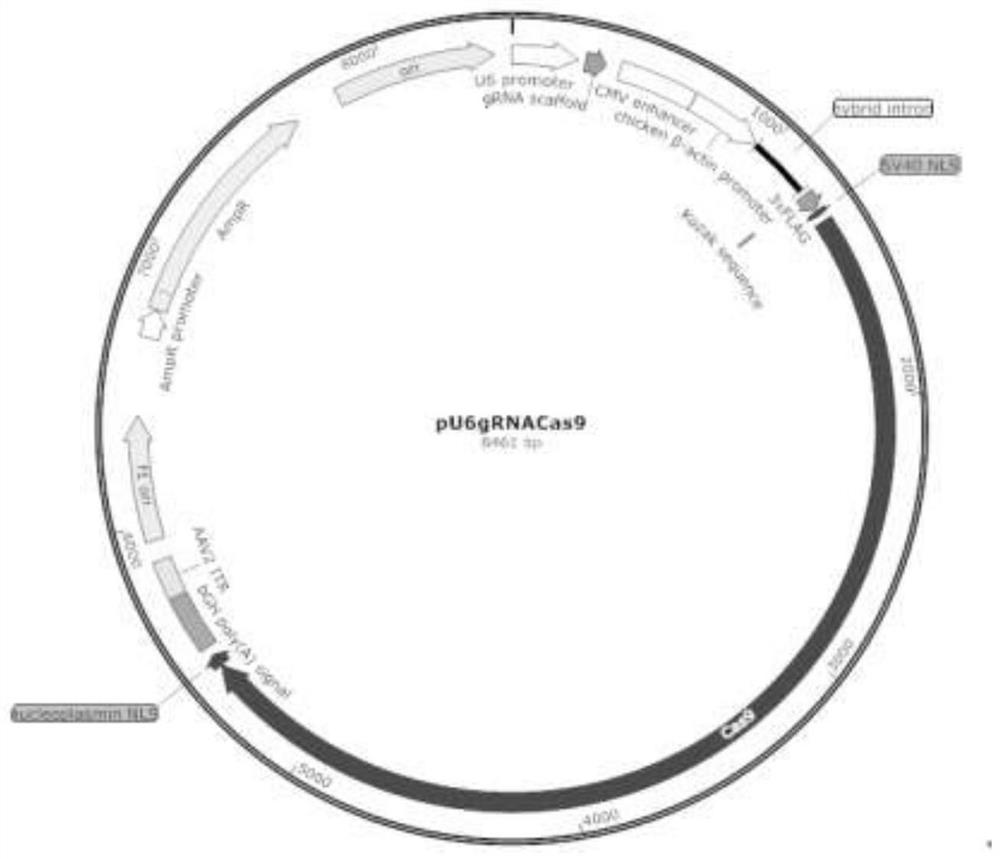CRISPR system for constructing double-gene combined knockout atherosclerotic porcine nuclear transplantation donor cells and application ofCRISPR system
A gene and gene editing technology, applied in the biological field, can solve the problems of not being able to truly simulate human physiology, pathology, mouse body size, organ size, physiology, and pathology, and achieve low and high costs for cloning and breeding , the effect of high feeding cost
- Summary
- Abstract
- Description
- Claims
- Application Information
AI Technical Summary
Problems solved by technology
Method used
Image
Examples
Embodiment 1
[0087] Embodiment 1, the preparation of plasmid
[0088] 1.1 Preparation of plasmid pU6gRNA eEF1a-mNLS-hSpCas9-EGFP-PURO (plasmid pKG-GE3 for short)
[0089] The sequence of the original plasmid pX330-U6-Chimeric_BB-CBh-hSpCas9 (abbreviated as plasmid pX330) is shown in SEQ ID NO:1. The schematic diagram of the structure of plasmid pX330 is shown infigure 1 . In SEQ ID NO: 1, the 440-725 nucleotides form the CMV enhancer, the 727-1208 nucleotides form the chickenβ-actin promoter, and the 1304-1324 nucleotides encode the SV40 nuclear localization signal (NLS ), the 1325-5449th nucleotide encodes the Cas9 protein, and the 5450-5497th nucleotide encodes the nucleoplasmin nuclear localization signal (NLS).
[0090] Plasmid pU6gRNA eEF1a-mNLS-hSpCas9-EGFP-PURO ( Figure 5 ), referred to as plasmid pKG-GE3, the nucleotide is shown in SEQ ID NO:2. Compared with the plasmid pX330, the plasmid pKG-GE3 has been mainly modified as follows: ① Remove the residual gRNA backbone sequence...
Embodiment 2
[0103] Embodiment 2, the effect comparison of plasmid pX330 and plasmid pKG-GE3
[0104] Select high-efficiency gRNA targets located at the RAG1 gene:
[0105] Target of RAG1-gRNA4: 5'-AGTTATGGCAGAACTCAGTG-3' (SEQ ID NO: 9).
[0106] Primers used to amplify and detect target-containing fragments are as follows:
[0107] RAG1-nF126: 5'-CCCCATCCAAAGTTTTTAAAGGA-3' (SEQ ID NO: 10);
[0108] RAG1-nR525: 5'-TGTGGCAGATGTCACAGTTTAGG-3' (SEQ ID NO: 11)
[0109] Primary porcine fibroblasts were prepared from the ear tissue of newborn Congjiang pigs (female, blood type AO).
[0110] 1. Preparation of recombinant plasmids
[0111] The plasmid pKG-U6gRNA was taken, digested with restriction endonuclease BbsI, and the vector backbone (a large linear fragment of about 3 kb) was recovered. RAG1-4S and RAG1-4A were synthesized separately, then mixed and annealed to obtain double-stranded DNA molecules with cohesive ends. The double-stranded DNA molecule with cohesive ends and the vector ...
Embodiment 3
[0134] Example 3, Target Screening for APOE Gene Knockout
[0135] Pig APOE gene information: encodes apolipoprotein E protein; located on pig chromosome 6;
[0136] GeneID is 397576, Sus scrofa. The protein encoded by the porcine APOE gene is shown in GENBANK ACCESSIONNO.NP_999473.1 (linear CON 12-JAN-2018). In the genomic DNA, the porcine APOE gene has 3 exons, wherein the second exon and its upstream and downstream 400bp sequences are shown in SEQ ID NO: 14, and its encoded protein fragment is shown in SEQ ID NO: 15.
[0137] 1. APOE gene knockout preset target and adjacent genome sequence conservation analysis
[0138] 18 newborn Congjiang pigs, including 10 females (named 1, 2, 3, 4, 5, 6, 7, 8, 9, 10) and 8 males (named A, B, C, D , E, F, G, H).
[0139] Using the genomic DNA of 18 pigs as templates, PCR amplification was carried out using primer pairs (the target sequence of the primer pairs includes exon 2 of the porcine APOE gene), and then electrophoresis was per...
PUM
 Login to View More
Login to View More Abstract
Description
Claims
Application Information
 Login to View More
Login to View More - R&D
- Intellectual Property
- Life Sciences
- Materials
- Tech Scout
- Unparalleled Data Quality
- Higher Quality Content
- 60% Fewer Hallucinations
Browse by: Latest US Patents, China's latest patents, Technical Efficacy Thesaurus, Application Domain, Technology Topic, Popular Technical Reports.
© 2025 PatSnap. All rights reserved.Legal|Privacy policy|Modern Slavery Act Transparency Statement|Sitemap|About US| Contact US: help@patsnap.com



